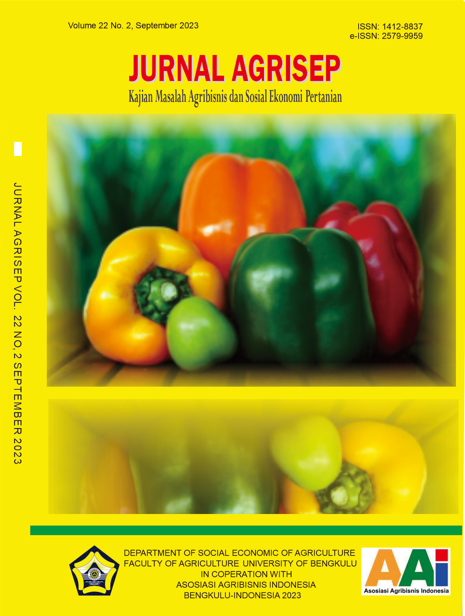Main Article Content
Abstract
The development of Aik Nibung agro-ecotourism ARD Garden in Badau Village is a post-tin mining management business. This activity cannot be separated from the mainstay role of farmers in this management. This study aimed to identify various forms of business management of post-tin mining land by leading farmers and to describe community perceptions of post-tin mining land management in Badau Village. This research is a case study with a descriptive research method and is analyzed qualitatively using a Likert scale. Sampling was done purposively (purposive sampling) with a total of 30 respondents. Data was collected through questionnaires, observations, interviews, and documentation. The results showed that: 1) The business managed by farmers is the mainstay in developing the Aik Nibung agro-ecotourism area ARD Garden, namely celocia, sunflower and button flower gardens, horticultural plant cultivation and tilapia fish cultivation; 2) The community's perception of pre-management of post-tin mining land is in agreement with an index coefficient value of 78.2%. Community perceptions of post-mining land management agree with an index coefficient value of 78.7% and community perceptions of successful post-mining land management strongly agree with an index coefficient value of 83.17%. With an average index coefficient value of 80.02% at the level of strongly agree.
Keywords
Article Details
Copyright (c) 2023 Nurida, Evahelda, Fournita Agustina

This work is licensed under a Creative Commons Attribution-ShareAlike 4.0 International License.
Authors who publish with this journal agree with the following terms:
- Authors retain copyright and grant the journal right of first publication with the work simultaneously licensed under a Creative Commons Attribution-ShareAlike 4.0 International License that allows others to share the work with an acknowledgment of the work's authorship and initial publication in this journal.
- Authors are able to enter into separate, additional contractual arrangements for the non-exclusive distribution of the journal's published version of the work (e.g., post it to an institutional repository or publish it in a book), with an acknowledgment of its initial publication in this journal.
- Authors are permitted and encouraged to post their work online (e.g., in institutional repositories or on their website) prior to and during the submission process, as it can lead to productive exchanges, as well as earlier and greater citation of published work (See The Effect of Open Access).
- This work is licensed under a Creative Commons Attribution-ShareAlike 4.0 International License.
References
- Fahrezza, F., & Asyiawati, Y. (2016). Kajian Nilai Manfaat Kawasan Agrowisata Bagi Masyarakat di Kawasan Wisata Agro Ubud. Prosiding Perencanaan Wilayah Dan Kota.
- Fitriana, I., 1, U., Setiawan, A., Rahmawati, A., & Abstrak, I. A. (2017). Politik Indonesia Indonesian Political Science Review Pembangunan Desa Berbasis Potensi Lokal Agrowisata di Desa Bumiaji, Kota Batu, Jawa Timur. http://journal.unnes.ac.id/nju/index.php/JPI
- Gunawan, I. (2016). Pengembangan Agrowisata untuk Kemandirian Ekonomi dan Pelestarian Budaya di Desa Kerta, Payangan Gianyar. JUMPA, 3(1).
- Irzon, R. (2021). Penambangan timah di Indonesia: Sejarah, masa kini, dan prospeksi. Jurnal Teknologi Mineral Dan Batubara, 17(3), 179–189. https://doi.org/10.30556/jtmb.Vol17.No3.2021.1183
- Kamino, S. (2015). Kebijakan Pemerintah Membangun Sektor Pertanian dalam Perspektif Pariwisata dan Membangun Pariwisata dalam Perspektif Pertanian. Farhan Fazri.
- Kurniawan, N. (2022). Keluar dari Ketergantungan Timah (1st ed.). Penerbit PolGov.
- Nurgiyantoro, B. (2010). Penilaian Pembelajaran Bahasa. BPFE.
- Nurmalia, A., & Handono, W. (2019). Analisis Partisipasi Dan Persepsi Petani Terhadap Restorasi Dan Preservasi Hutan. Jurnal AGRISEP: Kajian Masalah Sosial Ekonomi Pertanian Dan Agribisnis, 18(2), 305–312. https://doi.org/10.31186/jagrisep.18.2.305-312
- Pambudi, S. H., Sunarto, N., & Setyono, P. (2018). Strategi Pengembangan Agrowisata dalam Mendukung Pembangunan Pertanian - Studi Kasus di Desa Wisata Kaligono (Dewi Kano) Kecamatan Kaligesing Kabupaten Purworejo. Analisis Kebijakan Pertanian, 16(2), 165. https://doi.org/10.21082/akp.v16n2.2018.165-184
- Sekaran, U., & Bougie, R. (2016). Research Methods for Business : A Skill Building. Wiley.
- Septariani, D. N., Herawati, A., & Mujiyo, M. (2019). Pemanfaatan Berbagai Tanaman Refugia Sebagai Pengendali Hama Alami Pada Tanaman Cabai (Capsicum annum L.). PRIMA: Journal of Community Empowering and Services, 3(1), 1. https://doi.org/10.20961/prima.v3i1.36106
- Suriadikusumah, A. (2014). Pengaruh Aplikasi Hidrogel terhadap Beberapa Karakteristik Tanah Impaxct of Hydrogel Application on Some Soil Characteristics. Jurnal Teknotan, 8(1).
References
Fahrezza, F., & Asyiawati, Y. (2016). Kajian Nilai Manfaat Kawasan Agrowisata Bagi Masyarakat di Kawasan Wisata Agro Ubud. Prosiding Perencanaan Wilayah Dan Kota.
Fitriana, I., 1, U., Setiawan, A., Rahmawati, A., & Abstrak, I. A. (2017). Politik Indonesia Indonesian Political Science Review Pembangunan Desa Berbasis Potensi Lokal Agrowisata di Desa Bumiaji, Kota Batu, Jawa Timur. http://journal.unnes.ac.id/nju/index.php/JPI
Gunawan, I. (2016). Pengembangan Agrowisata untuk Kemandirian Ekonomi dan Pelestarian Budaya di Desa Kerta, Payangan Gianyar. JUMPA, 3(1).
Irzon, R. (2021). Penambangan timah di Indonesia: Sejarah, masa kini, dan prospeksi. Jurnal Teknologi Mineral Dan Batubara, 17(3), 179–189. https://doi.org/10.30556/jtmb.Vol17.No3.2021.1183
Kamino, S. (2015). Kebijakan Pemerintah Membangun Sektor Pertanian dalam Perspektif Pariwisata dan Membangun Pariwisata dalam Perspektif Pertanian. Farhan Fazri.
Kurniawan, N. (2022). Keluar dari Ketergantungan Timah (1st ed.). Penerbit PolGov.
Nurgiyantoro, B. (2010). Penilaian Pembelajaran Bahasa. BPFE.
Nurmalia, A., & Handono, W. (2019). Analisis Partisipasi Dan Persepsi Petani Terhadap Restorasi Dan Preservasi Hutan. Jurnal AGRISEP: Kajian Masalah Sosial Ekonomi Pertanian Dan Agribisnis, 18(2), 305–312. https://doi.org/10.31186/jagrisep.18.2.305-312
Pambudi, S. H., Sunarto, N., & Setyono, P. (2018). Strategi Pengembangan Agrowisata dalam Mendukung Pembangunan Pertanian - Studi Kasus di Desa Wisata Kaligono (Dewi Kano) Kecamatan Kaligesing Kabupaten Purworejo. Analisis Kebijakan Pertanian, 16(2), 165. https://doi.org/10.21082/akp.v16n2.2018.165-184
Sekaran, U., & Bougie, R. (2016). Research Methods for Business : A Skill Building. Wiley.
Septariani, D. N., Herawati, A., & Mujiyo, M. (2019). Pemanfaatan Berbagai Tanaman Refugia Sebagai Pengendali Hama Alami Pada Tanaman Cabai (Capsicum annum L.). PRIMA: Journal of Community Empowering and Services, 3(1), 1. https://doi.org/10.20961/prima.v3i1.36106
Suriadikusumah, A. (2014). Pengaruh Aplikasi Hidrogel terhadap Beberapa Karakteristik Tanah Impaxct of Hydrogel Application on Some Soil Characteristics. Jurnal Teknotan, 8(1).
